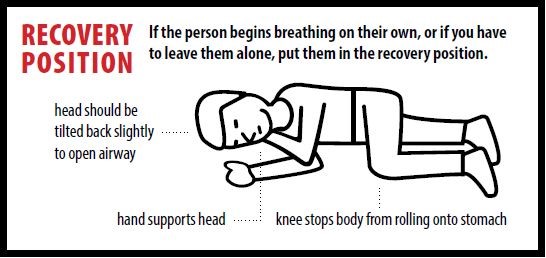What are the signs and symptoms of an opioid overdose?
An overdose may look different from one person to the next and depending on the drugs involved. An overdose is a medical emergency and the first step is always to call 911. The signs and symptoms of an opioid (like heroin, morphine, fentanyl, methadone, oxycontin) overdose are:
- Breathing is very slow, or irregular, or they may not be breathing at all
- Fingernails and/or lips are blue
- Body is limp
- Deep snoring or gurgling sounds
- Loss of consciousness/passed out (can’t wake the person up)
- Unresponsive (not answering when you talk to them or shake them)
- Pinpoint (tiny) pupils
What to do in case of overdose
![]()
![]()
![]()
![]()
![]()
- Shout and shake to check responsiveness
- Call 9-1-1 if not responsive. Speak calmly and clearly. Tell the dispatcher someone is unconscious and not responding. The dispatcher will ask you a few questions about your location and the situation.
- Emergency workers are there to save lives, not to judge. You can’t be charged for simple possession of illegal drugs, or for pre-trial release, probation orders, conditional sentencing or parole violations related to simple possession when calling for help in an overdose. This exemption applies to you or anyone you are calling 911 for.
- Give naloxone.
- Perform rescue breathing and/or chest compressions
- Is it working? If no improvement after 2-3 minutes, repeats steps 3 and 4.
- Stay with them.
If you have to leave the person at any time put them in the recovery position. The recovery position helps keep a person’s airway open so they can breathe and can prevent them from choking on vomit or spit.
Recovery Position


- Extend person’s closest arm above their head.
- Position other arm across their chest and bend their furthest leg at the knee. Person is then rolled toward you and placed on their side.
- Lay person on their side with their head stabilized on extended arm. Knee is bent to stabilize them.
It is important to stay with a person after giving them naloxone and until EMS arrive:
- The person may be confused and frightened when they wake up. You will need to tell them what happened and reassure them.
- A lot of opioids can last longer in the body than naloxone, so an overdose could return. It is important to make sure that the person knows not to take any more drugs.
- It is important to tell paramedics everything you know about the situation so they can provide the best care.
- Naloxone may cause people who have used opioids to go into withdrawal. This may make the person want to use again. Using more will increase the risk of overdose as the naloxone wears off.
- This can be very uncomfortable for the person but is not life threatening. Withdrawal symptoms may include:
- Muscle aches
- Sweating
- Nausea/vomiting
- Agitation
- Irritability
- Withdrawal may make the person want to use again. Using more drugs will increase the risk of a repeat overdose as the naloxone wears off.
Visit our local opioid resources page for where to get a take-home naloxone kit and training.
Watch the video below for an introduction to naloxone and how to recognize an opioid overdose.
Adapted with permission of Ottawa Public Health. For educational and non-commercial purposes.
Substance Harm Information & Education Dashboard (SHIELD)
Wellington-Dufferin-Guelph Public Health’s Substance Harm Information & Education Dashboard (SHIELD) allows users to explore the most recent information regarding substance use harms, as well as local substance use patterns through the FAST Overdose Alert System. SHIELD is an interactive tool that provides interested individuals the opportunity to explore information for Wellington, Dufferin and Guelph (WDG) by year, age, and sex.
Additional Information and Resources
- Are you a community agency or organization looking to become a naloxone distributor, visit Naloxone Training for Distributors.
- Are you an employer, looking to get Naloxone for your workplace? Visit Naloxone in the Workplace for more information.
- carrynaloxONe - Opioid Overdose and Naloxone Administration presentation (PPT): Summarizes the teaching points you will need to cover when distributing a naloxone kit. It goes through more detail on recognizing an overdose, the steps in giving naloxone and calling 911, the Good Samaritan Act and principles of preventing an overdose.
- Opioid Overdose Signs and Symptoms poster (PDF, 1 page).
- Good Samaritan Act Wallet Card (PDF, 1 page).
